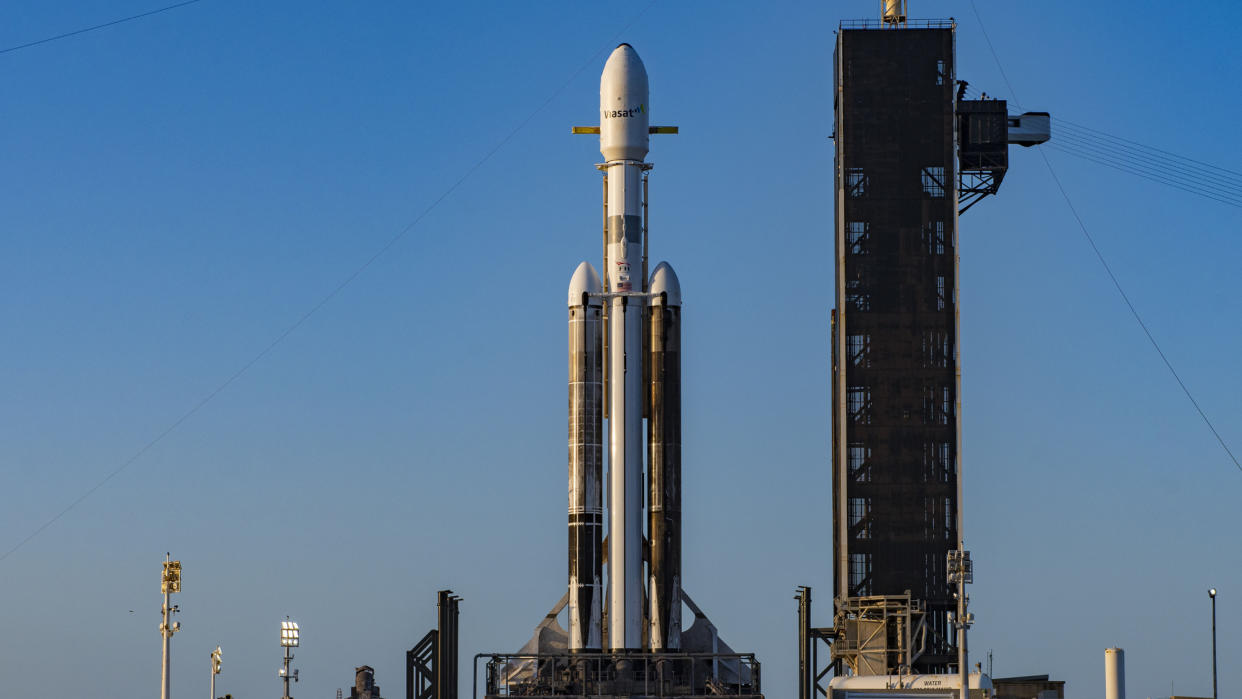Watch SpaceX's powerful Falcon Heavy rocket launch on 6th mission today

Update for April 26, 11:40 a.m. EDT: SpaceX is now targeting Thursday, April 27, to launch its sixth Falcon Heavy mission carrying satellites for Astranis and ViaSat.
SpaceX's powerful Falcon Heavy rocket will launch for the sixth time ever Thursday (April 27), and you can watch the action live.
The Falcon Heavy is scheduled to lift off from NASA's Kennedy Space Center in Florida at 7:29 p.m. EDT (2329 GMT), carrying two satellites toward distant geostationary orbit.
You can watch the liftoff live here at Space.com, courtesy of SpaceX, or directly via the company.
Related: SpaceX's 1st Falcon Heavy rocket launched Elon Musk's Tesla into space 5 years ago

The primary payload on today's mission is ViaSat-3 Americas, a 14,000-pound (6,400 kilograms) broadband satellite that will be operated by California-based company Viasat.
The second satellite flying today is Arcturus, a communications craft that will be operated by San Francisco-based Astranis Space Technologies.
"Although it only weighs 300 kg [660 pounds], the mighty communications satellite has the ability to provide data throughput up to 7.5 Gbps for ... Alaska and the surrounding region," EverydayAstronaut.com wrote of Arcturus in a description of today's flight.
RELATED STORIES:
— SpaceX Falcon Heavy launch spotted from space station (photo)
— Facts about SpaceX's Falcon Heavy rocket
— SpaceX's Falcon Heavy rocket launches classified mission for US Space Force
The Falcon Heavy consists of three strapped-together first stages of SpaceX's workhorse Falcon 9 rocket. The central booster is topped with an upper stage and the payload(s).
Falcon Heavy debuted in February 2018 with a memorable test flight flight that sent SpaceX founder and CEO Elon Musk's red Tesla Roadster into orbit around the sun with Starman, a spacesuit-clad mannequin, at the wheel.
The burly rocket has flown four more times since then, most recently in January of this year, when it launched the classified USSF-67 mission for the U.S. Space Force.
The Falcon Heavy's three first-stage boosters are designed to be reusable. However, none of the boosters will be recovered on today's mission, presumably because they won't have enough fuel left over to maneuver themselves safely back to Earth for a vertical touchdown.
For more than five years, the Falcon Heavy was SpaceX's most powerful rocket. But the company's gigantic Starship vehicle took that title with its debut liftoff on April 20, a test flight that reached a maximum altitude of 24 miles (39 kilometers) and ended in a commanded explosion high above the Gulf of Mexico for safety's sake.
Starship's 33 first-stage Raptor engines generate 16.7 million pounds of thrust at liftoff, according to SpaceX. That's more than three times more than the Falcon Heavy produces, and nearly twice as much as the second-place vehicle, NASA's Space Launch System megarocket.
Editor's note: This story has been corrected to state that Starship produces 16.7 million pounds (not tons) of thrust at liftoff.
Mike Wall is the author of "Out There" (Grand Central Publishing, 2018; illustrated by Karl Tate), a book about the search for alien life. Follow him on Twitter @michaeldwall. Follow us on Twitter @Spacedotcom or Facebook.

